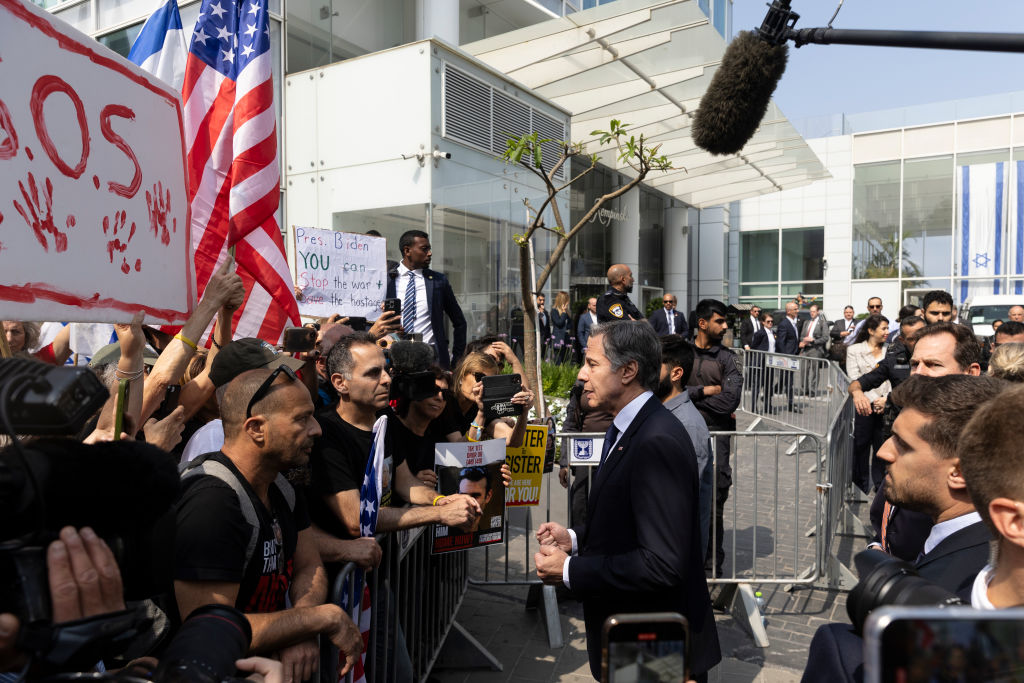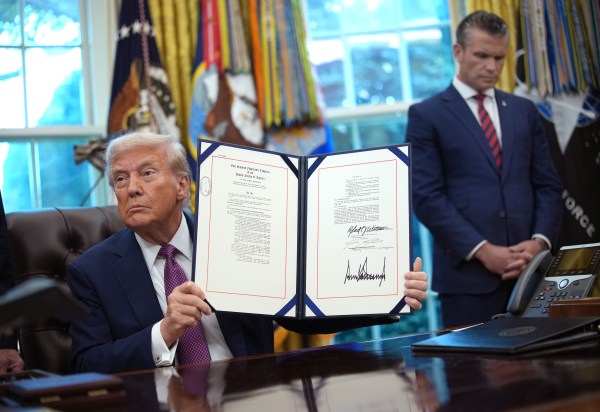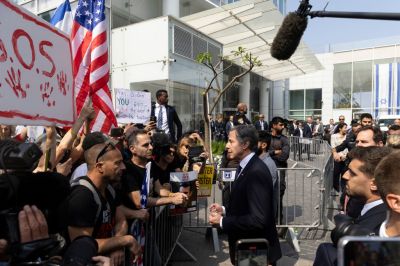TEL AVIV, Israel—Dozens of demonstrators carrying posters of hostages gathered outside of Secretary of State Antony Blinken’s Tel Aviv hotel on Wednesday morning with an unusual message: “Thank you.” The top U.S. diplomat and his entourage arrived in the country this week hoping to strike a long-awaited deal to bring the captives, including five Americans, out of Hamas custody after nearly seven months in Gaza.
“Bringing your loved ones home is at the heart of everything we’re trying to do, and we will not rest until everyone—man, woman, soldier, civilian, young, old—is back home,” Blinken told the assembled crowd. “There is a very strong proposal on the table right now. Hamas needs to say yes and needs to get this done.”
The U.S. and Israel presented a united front this week in a final diplomatic push to get the terror group to agree to a deal. In exchange for the multi-stage release of hostages, Israel has agreed to a temporary pause in fighting and the release of hundreds of Palestinian prisoners. But whether Hamas will abandon its maximalist demands, which include a full Israeli withdrawal from the Gaza Strip and a permanent ceasefire, remains unclear. The terror group’s response to the latest proposal is expected as soon as today.
Barring a breakthrough, the next phase of the war is imminent. The Israeli military in recent weeks made its final preparations for a ground offensive into Gaza’s southernmost city of Rafah, where the last Hamas battalions are sheltering among and beneath more than a million civilians. Though Israeli Prime Minister Benjamin Netanyahu has vowed to eliminate Hamas’ final stronghold “with or without a deal”—a point he reiterated to Blinken during their Wednesday meeting in Jerusalem—the date and scope of the operation may be determined by the outcome of this week’s negotiations.
Lebanese news outlet al-Akhbar published the contours of the latest U.S.-backed proposal on Wedneday, releasing a draft agreement that included significant concessions on the part of Israel. According to the report, Israel is willing to consider a “sustainable calm” in Gaza and the gradual withdrawal of its troops in exchange for the return of the remaining hostages—living and dead—in three stages.
In the first stage, Hamas would release up to 33 hostages from the humanitarian category—which includes women, children, the elderly, sick, and wounded—in return for a 40-day pause in fighting. In the second, the terror group would free all remaining men for a 42-day ceasefire. The third would see the return of dead hostages’ bodies to Israel for another 42-day pause, after which would begin a five-year plan for the reconstruction of the Gaza Strip. Hundreds of Palestinian prisoners, including those serving life sentences for killing Israelis, would also be freed as part of the deal. Displaced civilians would be permitted to return to northern Gaza, a reversal from Israel’s previous stance.
What isn’t included in the proposal is an explicit commitment to ending the war—a key demand of Hamas and a non-starter for Israel, which remains firm in its goal of destroying the terror group’s governing and military capabilities in Gaza. “The idea that we will halt the war before achieving all of its goals is out of the question,” Netanyahu told the family members of hostages on Tuesday.
Yet Hamas may see an opening in ongoing anti-Israel protests in cities and on college campuses in North America and Europe that, beyond calling for a ceasefire alone, have praised October 7 and embraced Hamas’ ideological commitment to the elimination of Israel. Izzat Al-Rishq, a member of Hamas’ political bureau, commended the demonstrators last week for “standing on the correct side of history.”
To the Biden administration, however, the onus to move forward with the deal is squarely on Hamas. Such was Blinken’s main message during his diplomatic blitz through Saudi Arabia, Israel, and Jordan this week, as he urged the terror group to accept Israel’s “extraordinarily generous” offer to halt the fighting. National Security Council spokesman John Kirby made a similar pitch in a press briefing Tuesday: “This is a really good proposal and Hamas ought to jump at it, and time is of the essence.”
Lazar Berman, a Jerusalem-based analyst and diplomatic correspondent at the Times of Israel, likewise views this latest proposal as Israel’s final offer ahead of a Rafah operation. “What’s clear is that there is unprecedented international pressure and diplomatic weight on Hamas to agree to this deal. It’s also clear that Israel is offering concessions beyond what I would’ve thought possible,” he told The Dispatch. “This is really as far as Israel can go.”
If talks fall through, as they have on multiple occasions throughout the nearly seven-month conflict, the Israel Defense Forces (IDF) is ready to push into southern Gaza as soon as the government gives the order. During a meeting with the head of Israel’s Southern Command on Sunday, IDF Chief of Staff Herzi Halevi approved “plans for the continuation of the war” in reference to the forthcoming offensive in Rafah. The military last week announced it had pulled the Nahal Brigade from the Gaza Strip to allow the infantry unit to rest and train in preparation for the ground operation.
As it has launched limited airstrikes on Rafah in recent days, Israel has also begun preparations to evacuate and provide shelter, food, and other humanitarian services to the city’s more than a million civilians, most of them displaced by fighting elsewhere in the Strip. Israeli officials reportedly assessed that the movement of Gazans to the nearby city of Khan Younis will take between two and three weeks, after which the IDF ground forces can begin clearing Rafah of its thousands of Hamas fighters neighborhood by neighborhood.
That Israel prevent further harm to civilians has been a key demand of the White House, which has previously opposed a major operation in Rafah in the absence of a clear plan to move Gazans out of harm’s way. During Blinken’s visit to southern Israel on Wednesday, Israeli officials showed the American delegation the location of the evacuation zones in Gaza and laid out their plans for getting food and medical treatment to sheltering Palestinians.
“The preparations are there. It will just take a decision from the political echelon, and the IDF will be in Rafah,” Berman said. “There’s nothing Hamas can do militarily to stop them.”







Please note that we at The Dispatch hold ourselves, our work, and our commenters to a higher standard than other places on the internet. We welcome comments that foster genuine debate or discussion—including comments critical of us or our work—but responses that include ad hominem attacks on fellow Dispatch members or are intended to stoke fear and anger may be moderated.
With your membership, you only have the ability to comment on The Morning Dispatch articles. Consider upgrading to join the conversation everywhere.